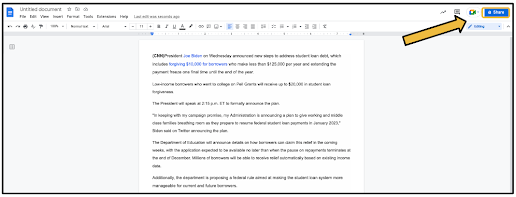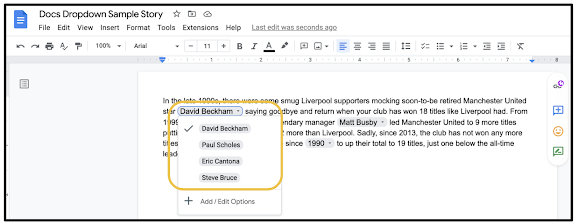Tuesday, August 30, 2022
Google Classroom as a Fitness Tracker
Wednesday, August 24, 2022
Help Curb Plagiarism by Disabling Copy in Google Docs
An often heard pain point is how students have become too good at copying and pasting. This leads to blatant plagiarism. As educators, we are looking to get students to analyze and synthesize content in order to generate thoughts, opinions, claims and cite textual evidence. Too often, students will try to cut corners by copying and pasting content and claiming it as their own.
Google Docs, hiding in plain sight, has a feature that allows you to disable copying on a document you own. For example, if you have an article you want students to read, synthesize and analyze, you could copy and paste the text onto a Google Doc. Be sure to cite the source and or give credit to the author. Once on a Google Doc, click the Share button in the top right corner.
Friday, May 27, 2022
An Easy Way to Get Started Using Dropdown Menus in Google Docs
Recently, Google Docs added a new Dropdown menu feature. It can be easily accessed by typing the "@" symbol. The first time you try it, it will be at the top of the menu that appears. After the first time, it will be located at the bottom. Scroll down to access the feature. It can also be found via the Insert menu on the top toolbar.
Friday, May 20, 2022
Google Certification Update in COJUSD
This school year, we have reignited our drive to get as many educators as possible to earn Google Certification. So far this year, we have quite a few who have passed the Level 1 and Level 2 exams in addition to many doing recertification for the Level 1 exam. Both Level 1 and Level 2 certifications last three years. Take a look below at our newly minted Google Certified Educators Level 1, Level 2 and re-certified Level 1.
Google Certified Educator Level 1
Betsy Lutz, Blake Kelley, Isaak Gomez, Daljit Singh, Gary Roldan, Taylor Linn, Yanet Parra, Irma Garcia, Darlene Isaak, Karina Moya, Carol Montag, Gloria Carrillo, Gracie Valdez, Karina Milligan, Nora Celis, Joanna Green, Kaylee Cardosa. Denise Vanderwall, Julie Capistran, Miguel Gutierrez
Google Certified Educator Level 2
Chris Swanson, Felicia Valencia, Melissa Troncozo, Daljit Singh, Megan Thiessen
Google Certified Educator Level 1 Re-Certified
Chris Swanson, Jennifer Orosco, Kelly Pennebaker, Melissa Troncozo, Felicia Valencia, Nichole Jimenez
Friday, April 29, 2022
Plan the GIFT Collaboratively with Wipebook!
Floor to ceiling whiteboard walls are luxury most educators do not have. I am one of the fortunate educators whose learning space has floor to ceiling, magnetic whiteboard walls. They make teaching students and leading professional learning sessions a blast. But what about the times when I am not in my learning space where I don't have this amazing luxury? In those instances, Wipebook the rescue!
 |
| The Cardinal Innovation Center in Orosi, CA |
When I teach and or present in spaces other than my own, Wipebook allows me to design lessons as if I was still in the friendly confines of the Cardinal Innovation Center. Pinning up Wipebook pages around the room allows me to quickly and easily increase my dry erase, writable space to give students and teachers the ability to get up and make their thinking visible. With their ideas up, on the walls, on Wipebook pages, the ease and opportunities for feedback increase tremendously. In addition, this is conducive to fostering collaboration.
In my book, The Complete EdTech Coach: An Organic Approach to Supporting Digital Learning, my co-author Katherine Goyette and I promote a 4 C's lesson design style. We begin with a learning target/goal/standard and use a simple 4 square diagram to map out how students will engage with each of the 4 C's as a way of reaching the learning target/goal/standard. As we like to say, "When you plan with the 4 C's in mind, the tech takes care of itself."
Wipebook is great for departments and PLCs to collaboratively design 4 C's-infused lessons and learning experiences. They are lightweight, flexible, easy to transport and fit well on a tabletop. This allows all colleagues to easily gather around, brainstorm and plan. Simply gathering around a Wipebook page to design a lesson is like a family gathering to share a meal. In this instance, colleagues are sharing some edu-fellowship and fostering a culture of collaboration.
Start by writing your learning target/goal/standard at the top and drawing a basic 4 square diagram. Each of the 4 C's (communication, collaboration, creativity, critical thinking) will go in one of the 4 squares. From here, the conversation begins on how students will meet the learning target/goal/standards via each of the C's. If you download, the Wipeboard Scan app, you can easily keep a record of your planning with you and reuse the Wipebook. One of the simple, yet brilliant things about Wipebook is that they are reusable. Try doing that with chart paper!
Below is a sample from a "Causes of WWI" lesson my colleagues and I designed with Wipebook.
 |
| My wife Katherine and I right before our 4 C's Lesson Design session at 2019 NSTC Conference in Palm Springs. This was the first time we used Wipebook to facilitate this session. |
Monday, March 28, 2022
Translation in Google Docs Made Easy with Docs Paragraph Translate
Translation of text is one of the most basic ways we can begin to support English learners. When you don't speak another language, this can seem like a daunting task. Though not the most difficult thing in the world, opening Google Translate in another tab and hopping back and forth to copy and paste text is tedious and annoying. But what if you could translate targeted text from right within Google Docs? Would that be so much easier? Spoiler alert, the answer is yes and the Docs Paragraph Translate Add On in Google Docs is here to help.
Start by going to the Add-Ons tab in Google Docs, go to Get add-ons, search for Docs Paragraph Translate and install. Once installed, it'll appear in your Add-ons list as seen below.
Friday, March 25, 2022
Update to Chrome Reading List: Quite a Handy Little Feature
If you are reading a website, and you want to save it for later, but not set it as a bookmark, the Reading List will be your best friend. With the Reading List open, click the button labeled Add current tab. This will save the URL (link) to your Reading List.












































